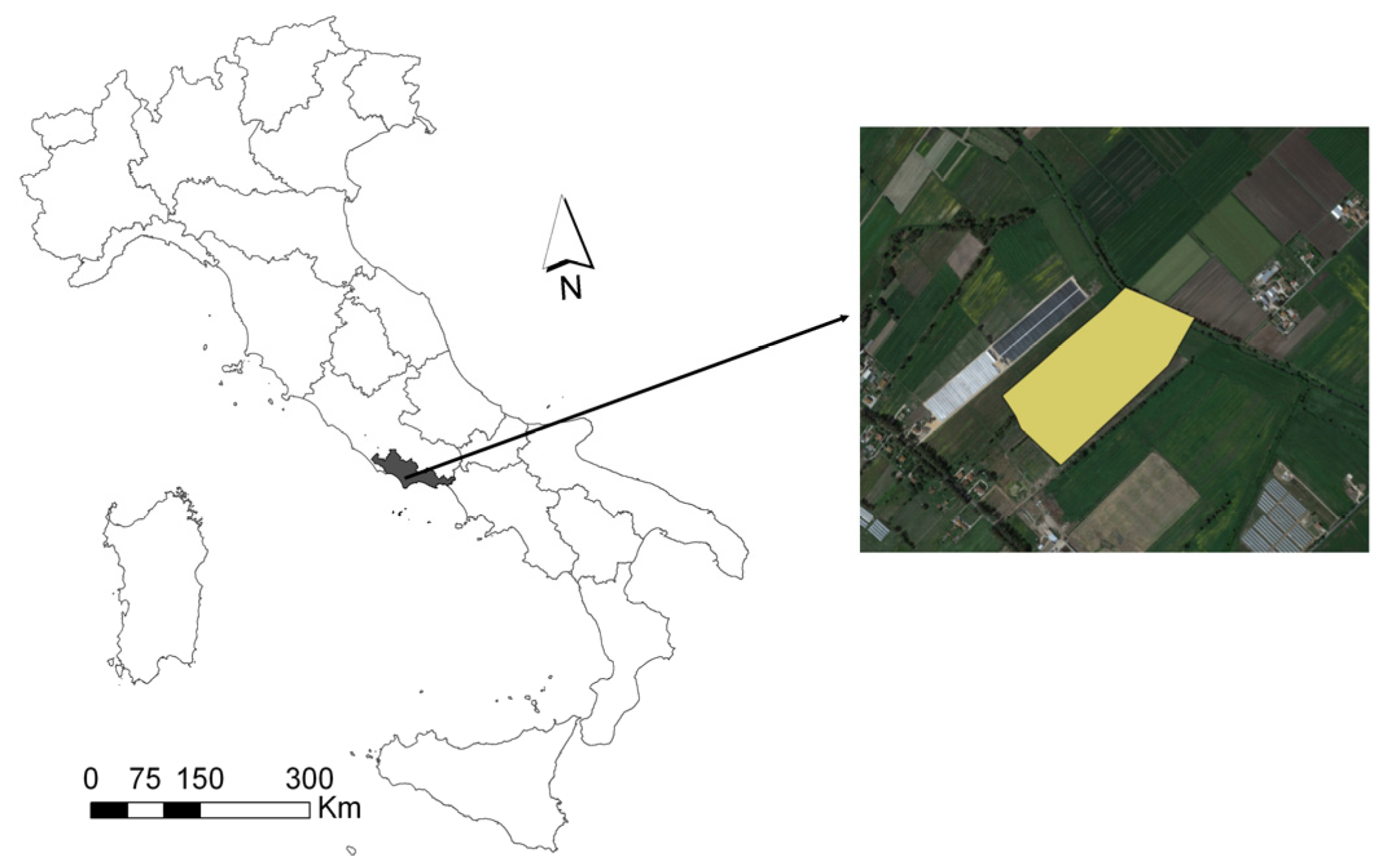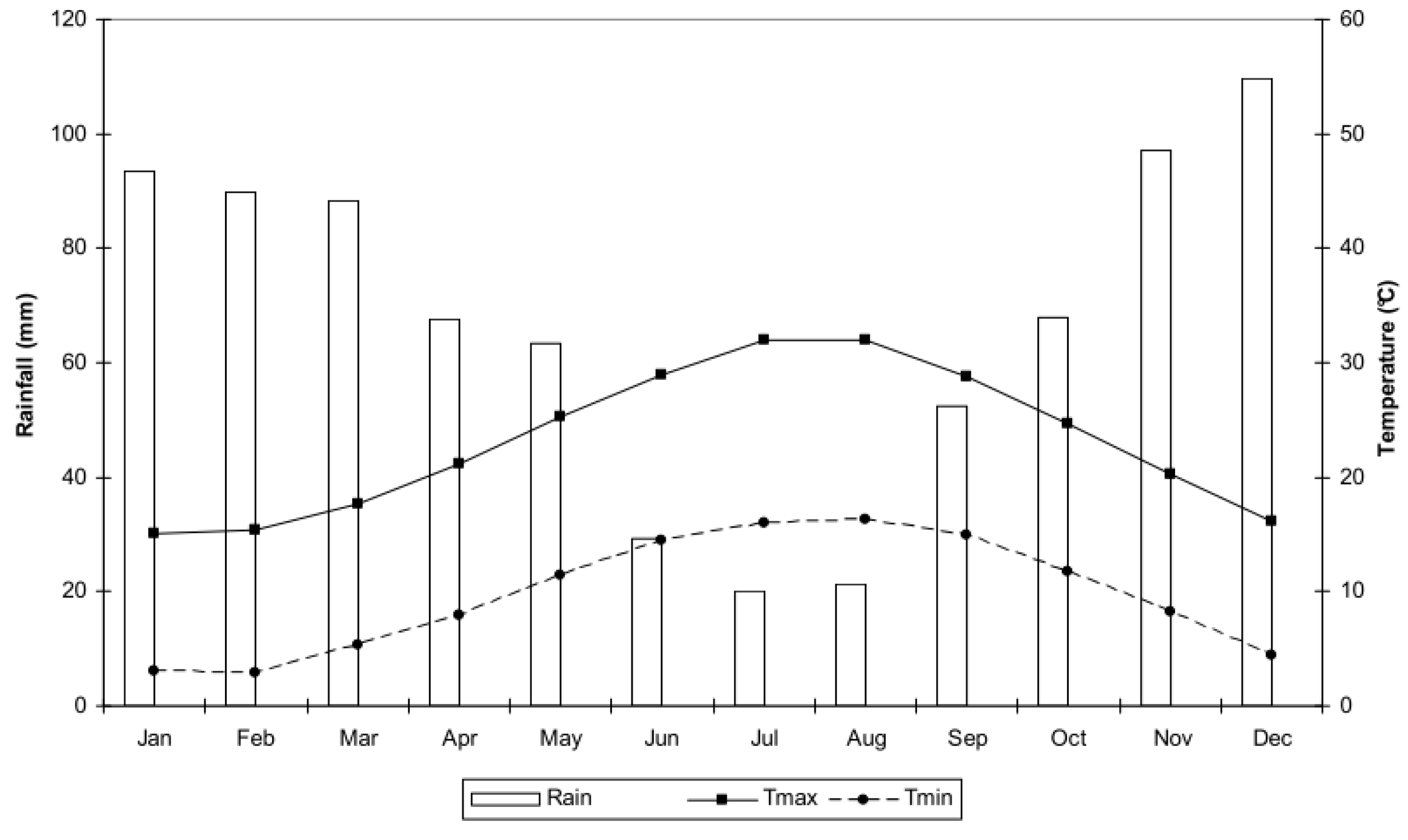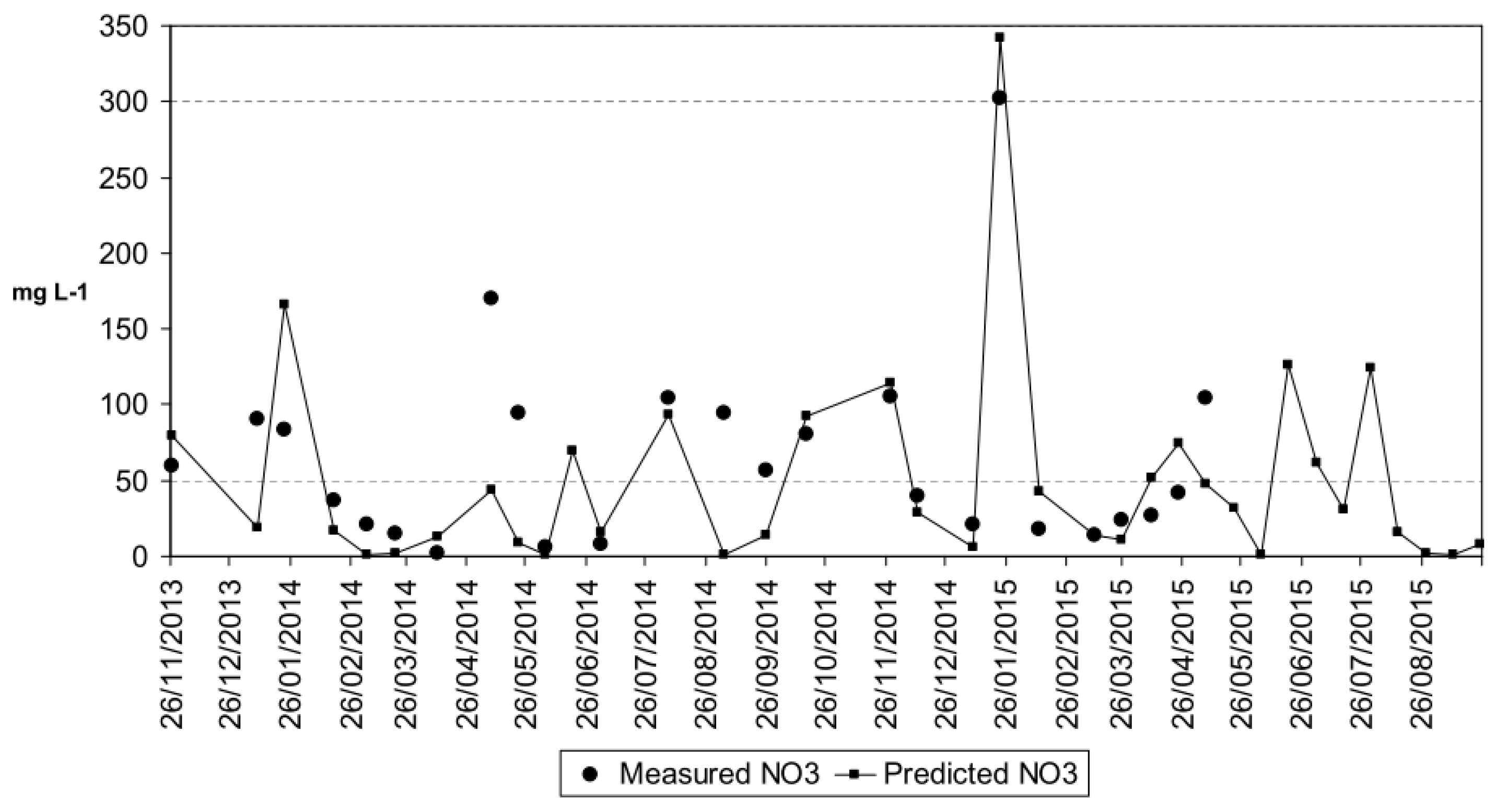Assessing Nitrogen Use Efficiency and Nitrogen Loss in a Forage-Based System Using a Modeling Approach
Abstract
:1. Introduction
2. Materials and Methods
2.1. Site Description and Data Collection
2.2. Nitrogen Balance and Nitrogen Use Efficiency (NUE) Calculation
2.3. Model Simulation
- S0: Baseline;
- S1: 50% reduction of both organic and mineral fertilization rates, maintaining the same application dates;
- S2: omission of the mineral fertilization in Italian ryegrass cycle only;
- S3: elimination of the mineral fertilization on both Italian ryegrass and silage corn cycles.
3. Results and Discussion
3.1. Nitrogen Balance and Nitrogen Use Efficiency
3.2. Nitrogen Leaching and WinEPIC Simulation
3.3. Fertilizer Management Scenarios
4. Conclusions
Acknowledgments
Conflicts of Interest
References
- D’Haene, K.; Salomez, J.; De Neve, S.; De Waele, J.; Hofman, G. Environmental performance of nitrogen fertiliser limits imposed by the EU nitrates directive. Agr. Ecosyst. Environ. 2014, 192, 67–79. [Google Scholar] [CrossRef]
- Sánchez Pérez, J.M.; Antigüedad, I.; Arrate, I.; García-Linares, C.; Morell, I. The influence of nitrogen leaching through unsaturated soil on groundwater pollution in an agricultural area of the Basque country. Sci. Total Environ. 2003, 317, 173–187. [Google Scholar] [CrossRef]
- Arauzo, M.; Valladolid, M. Drainage and N-leaching in alluvial soils under agricultural land uses: implications for the implementation of the EU Nitrates Directive. Agric. Ecosyst. Environ. 2013, 179, 94–107. [Google Scholar] [CrossRef]
- Shepherd, M.A.; Chambers, B. Managing nitrogen on the farm: The devil is in the detail. J. Sci. Food Agric. 2007, 87, 558–568. [Google Scholar] [CrossRef]
- Plaza-Bonilla, D.; Nolot, J.M.; Raffaillac, D.; Justes, E. Cover crops mitigate nitrate leaching in cropping systems including grain legumes: Field evidence and model simulations. Agric. Ecosyst. Environ. 2015, 212, 1–12. [Google Scholar] [CrossRef]
- Quinton, J.N.; Govers, G.; van Oost, K.; Bardgett, R.D. The impact of agricultural soil erosion on biogeochemical cycling. Nat. Geosci. 2010, 3, 311–314. [Google Scholar] [CrossRef] [Green Version]
- Knudsen, M.T.; Kristensen, I.S.; Berntsen, J.; Petersen, B.M.; Kristensen, E.S. Estimated N leaching losses for organic and conventional farming in Denmark. J. Agric. Sci. 2006, 144, 135–149. [Google Scholar]
- Kros, J.; Frumau, K.F.A.; Hensen, A.; de Vries, W. Integrated analysis of the effects of agricultural management on nitrogen fluxes at landscape scale. Environ. Pollut. 2011, 159, 3171–3182. [Google Scholar] [CrossRef] [PubMed]
- Poudel, D.D.; Horwath, W.R.; Mitchell, J.P.; Temple, S.R. Impacts of cropping systems on soil nitrogen storage and loss. Agri. Syst. 2001, 68, 253–268. [Google Scholar] [CrossRef]
- Destouni, G.; Darracq, A. Nutrient cycling and N2O emissions in a changing climate: the subsurface water system role. Environ. Res. Lett. 2009, 4, 035008. [Google Scholar] [CrossRef]
- Milne, A.E.; Haskard, K.A.; Webster, C.P.; Truan, I.A.; Goulding, K.W.T.; Lark, R.M. Wavelet analysis of the correlations between soil properties and potential nitrous oxide emission at farm and landscape scales. Eur. J. Soil Sci. 2011, 62, 467–478. [Google Scholar] [CrossRef]
- Colombo, C.; Palumbo, G.; Sellitto, V.M.; Di Iorio, E.; Castrignanò, A.; Stelluti, M. The effects of land use and landscape on soil nitrate availability in Southern Italy (Molise region). Geoderma 2015, 239–240, 1–12. [Google Scholar] [CrossRef]
- Laegreid, M.; Bøckman, O.C.; Kaarstad, O. Agriculture, Fertilizers and the Environment; CABI Publishing: Porsgrunn, Norway, 1999. [Google Scholar]
- Velthof, G.L.; Oudendag, D.; Witzke, H.P.; Asman, W.A.H.; Klimont, Z.; Oenema, O. Integrated assessment of nitrogen emissions from agriculture in EU-27 using MITERRA-Europe. J. Environ. Qual. 2009, 38, 402–417. [Google Scholar] [CrossRef] [PubMed]
- Bouwman, A.F.; Beusen, A.H.W.; Billen, G. Human alteration of the global nitrogen and phosphorus soil balances for the period 1970–2050. Global Biogeochem. Cy. 2009, 23, GB0A04. [Google Scholar] [CrossRef]
- Bouwman, A.F.; Beusen, A.H.W.; Griffioen, J.; Van Groenigen, J.W.; Hefting, M.M.; Oenema, O.; van Puijenbroek, P.J.T.M.; Seitzinger, S.; Slomp, C.P.; Stehfest, E. Global trends and uncertainties in terrestrial denitrification and N2O emissions. Philos. Trans. Royal Soc. B-Biol. Sci. 2013, 368, 20130112. [Google Scholar] [CrossRef]
- Gibbons, J.M.; Williamson, J.C.; Prysor Williams, A.; Withers, P.J.A.; Hockley, N.; Harris, I.M.; Hughes, J.W.; Taylor, R.L.; Jones, D.L.; Healey, J.R. Sustainable nutrient management at field, farm and regional level: Soil testing, nutrient budgets and the trade-off between lime application and greenhouse gas emissions. Agric. Ecosys. Environ. 2014, 188, 48–56. [Google Scholar] [CrossRef]
- Eichler, F.; Schulz, D. The nitrogen reduction program in the Federal Republic of Germany. Environ. Pollut. 1998, 102, 609–617. [Google Scholar] [CrossRef]
- Council of the European Communities Council Directive 91/676/EEC of 12 December 1991 concerning the protection of waters against pollution caused by nitrates from agricultural sources. Available online: http://eur-lex.europa.eu/legal-content/EN/TXT/?uri=CELEX%3A31991L0676 (accessed on 11 April 2016).
- Oenema, O.; Kros, H.; de Vries, W. Approaches and uncertainties in nutrient budgets: implications for nutrient management and environmental policies. Eur. J. Agron. 2003, 20, 3–16. [Google Scholar] [CrossRef]
- Gardner, K.K.; Vogel, R.M. Predicting ground water nitrate concentration from land use. Ground Water 2005, 43, 1–10. [Google Scholar] [CrossRef] [PubMed] [Green Version]
- Giola, P.; Basso, B.; Pruneddu, G.; Giunta, F.; Jones, J.W. Impact of manure and slurry applications on soil nitrate in a maize-triticale rotation: field study and long term simulation analysis. Eur. J. Agron. 2012, 38, 43–53. [Google Scholar] [CrossRef]
- Daudén, A.; Quílez, D.; Vera, M.V. Pig slurry application and irrigation effects on nitrate leaching in Mediterranean soil lysimeters. J. Environ. Qual. 2004, 33, 2290–2295. [Google Scholar] [CrossRef] [PubMed]
- Chambers, B.J.; Smith, K.A.; Pain, B.F. Strategies to encourage better use of nitrogen in animal manures. Soil Use Manage. 2000, 16, 157–166. [Google Scholar] [CrossRef]
- Trindade, H.; Coutinho, J.; van Beusichem, M.L.; Scholefield, D.; Moreira, N. Nitrate leaching from sandy loam soil under a double-cropping forage system estimate from suction-probe measurements. Plant Soil 1997, 195, 247–256. [Google Scholar] [CrossRef]
- Trindade, H.; Coutinho, J.; Jarvis, S.; Moreira, N. Effects of different rates and timing of application of nitrogen as slurry and mineral fertilizer on yield of herbage and nitrate-leaching potential of a maize/Italian ryegrass cropping system in north-west Portugal. Grass Forage Sci. 2009, 64, 2–11. [Google Scholar] [CrossRef]
- Li, C.; Farahbakhshazad, N.; Jaynes, D.B.; Dinnes, D.L.; Salas, W.; McLaughlin, D. Modeling nitrate leaching with a biogeochemical model modified based on observations in a row-crop field in Iowa. Ecol. Model. 2006, 196, 116–130. [Google Scholar] [CrossRef]
- Xu, L.; Niu, H.; Xu, J.; Wang, X. Nitrate-Nitrogen Leaching and Modeling in Intensive Agriculture Farmland in China. Sci. World J. 2013. Available online: http://dx.doi.org/10.1155/2013/353086 (accessed on 29 January 2016). [Google Scholar]
- Groenendijk, P.; Heinen, M.; Klammler, G.; Fank, J.; Kupfersberger, H.; Pisinaras, V.; Gemitzi, A.; Peña-Haro, S.; García-Prats, A.; Pulido-Velazquez, M.; et al. Performance assessment of nitrate leaching models for highly vulnerable soils used in low-input farming based on lysimeter data. Sci. Total Environ. 2014, 499, 463–480. [Google Scholar] [CrossRef] [PubMed]
- Roelsma, J.; Hendriks, R.F.A. Comparative study of nitrate leaching models on a regional scale. Sci. Total Environ. 2014, 499, 481–496. [Google Scholar] [CrossRef] [PubMed]
- Demurtas, C.E.; Seddaiu, G.; Ledda, L.; Cappaia, C.; Doro, L.; Carletti, A.; Roggero, P.P. Replacing organic with mineral N fertilization does not reduce nitrate leaching in double crop forage systems under Mediterranean conditions. Agric. Ecosys. Environ. 2016, 219, 83–92. [Google Scholar] [CrossRef]
- Koelsch, R. Evaluating livestock system environmental performance with whole-farm nutrient balance. J. Environ. Quality 2005, 34, 149–155. [Google Scholar]
- Grignani, C.; Zavattaro, L.; Sacco, D.; Monaco, S. Production, nitrogen and carbon balance of maize-based forage systems. Eur. J. Agron. 2007, 26, 442–453. [Google Scholar] [CrossRef]
- Bassanino, M.; Grignani, C.; Sacco, D.; Allisiardi, E. Nitrogen balances at the crop and farm-gate scale in livestock farms in Italy. Agric. Ecosys. Environ. 2007, 122, 282–294. [Google Scholar] [CrossRef]
- Cherry, K.A.; Shepherd, M.; Withers, P.J.A.; Mooney, S.J. Assessing the effectiveness of actions to mitigate nutrient loss from agriculture: A review of methods. Sci. Total Environ. 2008, 406, 1–23. [Google Scholar] [CrossRef] [PubMed]
- Goulding, K. Nitrate leaching from arable and horticultural land. Soil Use Manage. 2000, 16, 145–151. [Google Scholar] [CrossRef]
- Sieling, K.; Kage, H. N balance as an indicator of N leaching in an oilseed rape - winter wheat-winter barley rotation. Agric. Ecosys. Environ. 2006, 115, 261–269. [Google Scholar] [CrossRef]
- Grignani, C.; Bassanino, M.; Allisiardi, E.; Sacco, D. Nitrogen balances at the crop and at the farm-gate scale in NW Italy stocking farms. In Proceedings of the 14th N-Workshop “N management in agro-systems in relation to the Water Framework Directive”, Wageningen, The Netherlands, 24–26 October 2005.
- Sacco, D.; Bassanino, M.; Grignani, C. Developing a regional agronomic information system for estimating nutrient balances at a larger scale. Eur. J. Agron. 2003, 20, 199–210. [Google Scholar] [CrossRef]
- IUSS Working Group WRB. World Reference Base for Soil Resources 2014 International Soil Classification System for Naming Soils and Creating Legends for Soil Maps; World soil resources reports No. 103; Food and Agriculture Organization of the United Nations: Rome, Italy, 2014. [Google Scholar]
- SSSA (Soil Science Society of America). Book Series no. 5. Methods of Soil Analysis. Part 1. Physical and Mineralogical Methods; SSSA Publisher: Madison, WI, USA, 1986. [Google Scholar]
- SSSA (Soil Science Society of America). Book Series no. 5. Methods of Soil Analysis. Part 3. Chemical Methods; SSSA Publisher: Madison, WI, USA, 1996. [Google Scholar]
- Faugno, S.; Pindozzi, S.; Infascelli, R.; Okello, C.; Ripa, M.N.; Boccia, L. Assessment of nitrogen content in buffalo manure and land application costs. J. Agric. Engin. 2012, 43, 86–92. [Google Scholar]
- Constantin, J.; Mary, B.; Laurent, F.; Aubrion, G.; Fontaine, A.; Kerveillant, P.; Beaudoin, N. Effects of catch crops, no till and reduced nitrogen fertilization on nitrogen leaching and balance in three long-term experiments. Agric. Ecosys. Environ. 2010, 135, 268–278. [Google Scholar] [CrossRef]
- Pieri, L.; Ventura, F.; Vignudelli, M.; Rossi, P. Nitrogen balance in a hilly semi-agricultural watershed in Northern Italy. Ita. J. Agron. 2011, 6, 67–75. [Google Scholar] [CrossRef]
- Di Bene, C.; Tavarini, S.; Mazzoncini, M.; Angelini, L.G. Changes in soil chemical parameters and organic matter balance after 13 years of ramie [Boehmeria nivea (L.) Gaud.] cultivation in the Mediterranean region. Eur. J. Agron. 2011, 35, 154–163. [Google Scholar] [CrossRef]
- Masoni, A.; Pampana, S. Fertilizzazione azotata dei Cereali Autunno-vernini. 2003. Available online: http://www.irri.it/docs/fertilizzazioneazotata.pdf (accessed on 7 March 2016) . (in Italian).
- Dobermann, A. Nutrient use efficiency-Measurement and management. In Fertilizer Best Management Practices; IFA International Workshop on Fertilizer Best Management Practices (FBMPs): Brussels, Belgium, 2007; pp. 1–28. [Google Scholar]
- Williams, J.R.; Dyke, P.T.; Jones, C.A. EPIC: A model for assessing the effects of erosion on soil productivity. In Analysis of Ecological Systems: State-of-the-Art in Ecological Modeling; Lauenroth, W.K., Skogerboe, G.V., Flug, M., Eds.; Elsevier Scientific Publishing Company: Amsterdam, The Netherlands, 1983; pp. 553–572. [Google Scholar]
- Gassman, P.W.; Williams, J.R.; Benson, V.W.; Izaurralde, R.C.; Hauck, L.; Jones, C.A.; Atwood, J.D.; Kiniry, J.; Flowers, J.D. Historical development and applications of the EPIC and APEX models. In Working Paper 05-WP 397 Center for Agricultural and Rural Development; Iowa State University: Ames, IA, USA, 2005. [Google Scholar]
- He, X.; Izaurralde, R.C.; Vanotti, M.B.; Williams, J.R.; Thomson, A.M. Simulating long-term and residual effects of nitrogen fertilization on corn yields, soil carbon sequestration, and soil nitrogen dynamics. J. Environ. Qual. 2006, 35, 1608–1619. [Google Scholar] [CrossRef] [PubMed]
- David, M.B.; Del Grosso, S.J.; Hu, X.; Marshall, E.P.; McIsaac, G.F.; Parton, W.J.; Tonitto, C.; Youssef, M.A. Modeling denitrification in a tile-drained, corn and soybean agroecosystem of Illinois, USA. Biogeochemistry 2009, 93, 7–30. [Google Scholar] [CrossRef]
- Izaurralde, R.C.; Williams, J.R.; McGill, W.B.; Rosenberg, N.J.; Jakas, M.C.Q. Simulating soil C dynamics with EPIC: Model description and testing against long-term data. Ecol. Model. 2006, 192, 362–384. [Google Scholar]
- Schröder, J.J.; Aarts, H.F.M.; van Middelkoop, J.C.; Schils, R.L.M.; Velthof, G.L.; Fraters, B.; Willems, W.J. Permissible manure and fertilizer use in dairy farming systems on sandy soils in The Netherlands to comply with the Nitrates Directive target. Eur. J. Agron. 2007, 27, 102–114. [Google Scholar] [CrossRef]
- Infascelli, R.; Pelorosso, R.; Boccia, L. Spatial assessment of animal manure spreading and groundwater nitrate pollution. Geospatial Health 2009, 4, 27–38. [Google Scholar] [CrossRef] [PubMed]
- Zavattaro, L.; Monaco, S.; Sacco, D.; Grignani, C. Options to reduce N loss from maize in intensive cropping systems in Northern Italy. Agric. Ecosys. Environ. 2010, 135, 268–278. [Google Scholar] [CrossRef]
- Morari, F.; Giupponi, C. Effects of four cultivation systems for maize on nitrogen leaching 2. Model simulation. Eur. J. Agron. 1997, 6, 113–123. [Google Scholar] [CrossRef]



| Properties * | First layer (0–50) | Second layer (50–65) | Third layer (65–110) | Fourth layer (110–200) |
|---|---|---|---|---|
| Texture (USDA method) | Sandy Loam | Sandy Loam | Sandy Clay Loam | Sandy Clay Loam |
| Bulk density (T m−3) | 1.49 | 1.51 | 1.35 | 1.36 |
| Wilting point (m3 m−3) | 14.0 | 16.3 | 23.2 | 21.8 |
| Field capacity (m3 m−3) | 35.6 | 31.9 | 39.8 | 38.5 |
| pH | 7.0 | 7.5 | 7.6 | 8.7 |
| E.C. (dS m−1) | 0.64 | 0.20 | 0.37 | 0.51 |
| C.E.C. (cmol(+) kg−1) | 15.7 | 8.9 | 20.2 | 17.6 |
| Organic Matter (%) | 2.16 | 0.58 | 0.34 | 0.24 |
| Total N (g kg−1) | 1.3 | 0.4 | 0.3 | 0.2 |
| CaCO3 (%) | 0.0 | 0.0 | 0.0 | 0.2 |
| P (ppm) | 80 | 7 | 3 | 3 |
| Crop | Operation | Period | Rate | Nigroten |
|---|---|---|---|---|
| Italian ryegrass | ||||
| Plowing | First half of October | |||
| Fertilizer application | Second half of October | 300 kg·ha−1 (mineral) a | 36 kg·ha−1 | |
| 40,000 kg·ha−1 (organic) b | 78 kg·ha−1 | |||
| Seeding | End of October | 80 kg·ha−1 seeds | ||
| Fertilizer application | Second half of January | 180 kg·ha−1 (mineral) c | 83 kg·ha−1 | |
| Harvest | First decade of May | 8 Mg·ha−1 (as dry weight) d | 80 kg·ha−1 | |
| Silage corn | ||||
| Plowing | End of May | |||
| Fertilizer application | First half of June | 300 kg·ha−1 (mineral) a | 36 kg·ha−1 | |
| 40,000 kg·ha−1 (organic) b | 78 kg·ha−1 | |||
| Seeding | Middle June | 75,000 seeds ha−1 | ||
| Irrigation | Weekly, from seeding to | 50 mm each | ||
| Fertilizer application | Middle July | 200 kg·ha−1 (mineral) c | 92 kg·ha−1 | |
| Harvest | First decade of September | 15 Mg·ha−1 (as dry weight) d | 150 kg·ha−1 |
| N balance * | Ryegrass | Silage maize | Whole rotation |
|---|---|---|---|
| Input: | |||
| A | 16 | 16 | 16 |
| F | 197 | 206 | 404 |
| R | 12 | 23 | 35 |
| Total input | 225 | 245 | 470 |
| Output: | |||
| U | 80 | 150 | 230 |
| Balance: input − output | 145 | 95 | 224 |
| NUE (%) | 36 | 61 | 49 |
| Scenario | Italian ryegrass yield (Mg d.w. ha−1) | Silage corn yield | Average annual total soluble N (kg·ha−1) | Average annual N leaching rate (kg day−1 ha−1) |
|---|---|---|---|---|
| S0: Baseline | 9.3 | 11.0 | 198 | 4 |
| S1: 50% of total N fertilization | 9.0 | 10.7 | 118 | 3 |
| S2: No mineral N fertilization for Italian ryegrass | 9.1 | 10.9 | 80 | 3 |
| S3: Only organic N | 9.0 | 10.5 | 96 | 1 |
© 2016 by the authors; licensee MDPI, Basel, Switzerland. This article is an open access article distributed under the terms and conditions of the Creative Commons by Attribution (CC-BY) license (http://creativecommons.org/licenses/by/4.0/).
Share and Cite
Piccini, C.; Di Bene, C.; Farina, R.; Pennelli, B.; Napoli, R. Assessing Nitrogen Use Efficiency and Nitrogen Loss in a Forage-Based System Using a Modeling Approach. Agronomy 2016, 6, 23. https://doi.org/10.3390/agronomy6020023
Piccini C, Di Bene C, Farina R, Pennelli B, Napoli R. Assessing Nitrogen Use Efficiency and Nitrogen Loss in a Forage-Based System Using a Modeling Approach. Agronomy. 2016; 6(2):23. https://doi.org/10.3390/agronomy6020023
Chicago/Turabian StylePiccini, Chiara, Claudia Di Bene, Roberta Farina, Bruno Pennelli, and Rosario Napoli. 2016. "Assessing Nitrogen Use Efficiency and Nitrogen Loss in a Forage-Based System Using a Modeling Approach" Agronomy 6, no. 2: 23. https://doi.org/10.3390/agronomy6020023








